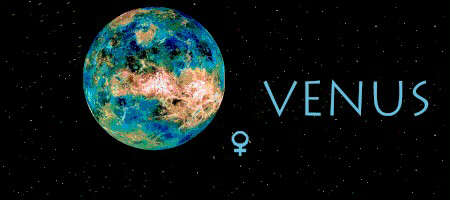|
|
|
 |
Second from the Sun, the Ancients called Venus the "Lesser Benefic", as she brings pleasure, happiness, wealth, good fortune, and love. She is the principle of attraction (you get more flies with honey than with vinegar), persuasion, getting along. Venus shows what you really enjoy. The house affairs indicated, are important in resolving karmic obligations; these affairs need to be worked on and the values reoriented. Venus brings good vibrations to the house, so that we will spend time attending to those house affairs.
The natural ruler of Taurus and Libra, Venus represents sociability, friendliness, harmony, balance, values, art, beauty, and romantic love (as opposed to sexual love which is Mars' domain). It shows your artistic side, what you value, how you relate to others. In Roman mythology Venus was the goddess of love and beauty.
Physically, Venus rules blood circultaion, kidneys, ovaries, throat, skin eruptions, and the equilibrium.
For colors, gemstones, and metals, Taurus is associated with strong blues, deep orange, and yellow; the gem emerald; and the metal copper. Libra is associated with blue, pink, soft rose, pale yellow and green; the gem of opal; the metal copper.
![]()
![]() Astronomical
data:
Astronomical
data:
*Mean distance from Sun: 0.72 AU; 108,200,000 km
*Diameter: 12,100 km
*Mass: 0.815 Earth-mass
*Density: 5.2 grams per cubic centimeter
*Surface temperature: 900 F
*Wind speeds: 0.3 to 1.0 m/s (surface)
*Atmospheric composition (near surface, by volume): *Carbon Dioxide 96.5%, Nitrogen 3.5%
*Trace amounts of: Sulfur dioxide, water vapor, carbon monoxide, argon, helium, neon, hydrogen chloride, and hydrogen fluoride
*Orbital period (Length of venusian year): 224.701 *Earth-days Rotational period: 243 days
*Length of venusian day: 243 Earth-days
*Tilt of axis ..... 177.36°
*Mean orbital velocity: 35.02 km/s
Early astronomers once thought Venus to be two separate bodies (although, from early writings, astrologers knew the difference between the rising and setting Venus, and ascribed different interpretations to each).
Named after the Roman goddess of love and beauty, she is veiled by thick swirling cloud cover. Often spoken of as Earth's sister planet, both are similar in size, mass, density and volume. Both formed about the same time and condensed out of the same nebula. However, Venus is very different from the Earth, as she has no oceans and is surrounded by a heavy atmosphere composed mainly of carbon dioxide with virtually no water vapor. The clouds are composed of sulfuric acid droplets.
Visited by spacecraft from both the U.S.A and Russia, much of the surface has been mapped by radar. These images (like the one above) show wide volcanic plains that surround mountainous regions. The largest highland areas, Aphrodite and Ishtar Terras, are similar in size to earthly continents like Africa and the Americas, but they seem to have formed in a much different manner. Earth's crust is made up of distinct, rigid plates that, over the eons, drift across its surface. Venus' crust does not seem to be broken into rigid plates, but instead moves and takes form in a more plastic manner.
The surface pressure on Venus is about 90 times that on Earth, and it is scorched with a surface temperature of about 482° C (900° F). This high temperature is primarily due to a runaway greenhouse effect caused by the heavy atmosphere of carbon dioxide. Sunlight passes through the atmosphere to heat the surface of the planet. Heat is radiated out, but is trapped by the dense atmosphere and not allowed to escape into space to allow cooling. This makes Venus hotter than Mercury.
A Venusian day is 243 Earth days and is longer than its year. Venus rotates from east to west, which would give the appearance of the Sun rising in the west and setting in the east.
[Sun] [Moon] [Mercury] [Venus] [Mars]
[Jupiter] [Saturn] [Uranus] [Neptune] [Pluto]
*Astrological Backgrounds Menu*
![]()